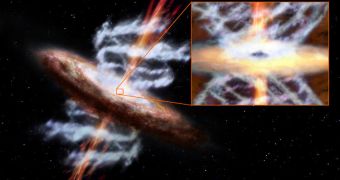Astronomers announce the discovery of cosmic gas clouds formed around supermassive black holes. These formations are not falling through the event horizon, as many expected, but rather are produced by the matter that should be consumed.
The reason this is interesting is that some of the matter that was supposed to feed the black hole is being used for something else. This suggests that gas cloud formation may be a process through which the growth of the dark behemoth is being regulated.
Additionally, the rate at which the host galaxy forms new stars may also be influenced, at least partially, by how much gas is produced in the areas surrounding the central, supermassive black hole.
The stellar formation feedback mechanism is a bit more complex. The gaseous outflows from the black hole may literally push hydrogen gas clouds away from the central regions of a galaxy. This is the location where gas is most likely to accumulate, and form stellar nurseries.
But the black hole may dissipate these structures, starving itself and forcing the host galaxy to stop growing, all at the same time. Astrophysicists say that more in-depth analyses of this process could finally reveal the nature of relationships proposed to exist between black holes and galaxies.
Over time, scientists theorized that they influence and control each other's development, but finding evidence to support this point of view has been extremely difficult. The new discovery could be the break scientists needed, Space reports.
The gas outflows “have the potential to play a major role in transmitting feedback effects from a black hole into the galaxy at large,” explains Francesco Tombesi, the researcher who led the new study. He is based at the NASA Goddard Space Flight Center (GSFC), in Greenbelt, Maryland.
He and his team published details of their new investigation in the February 27 issue of the esteemed scientific journal Monthly Notices of the Royal Astronomical Society.
The paper may also help explain why the mass of supermassive black holes at the center of galaxies influences the velocity of stars at the galactic core. “This was a real conundrum,” Tombesi explains.
“Everything was pointing to supermassive black holes as somehow driving this connection, but only now are we beginning to understand how they do it,” the investigator concludes.

 14 DAY TRIAL //
14 DAY TRIAL //